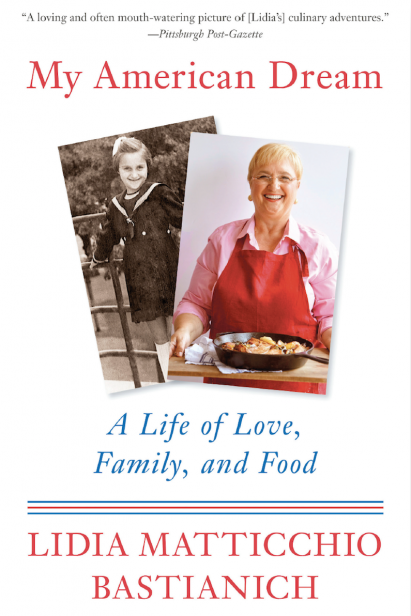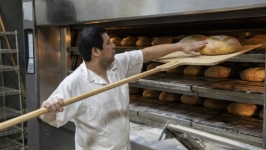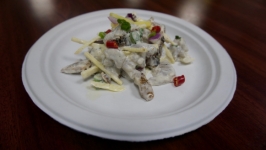My American Dream: A Life of Love, Family and Food
When Lidia Bastianich immigrated to Queens, she wasn’t yet the world-famous, Emmy-award-winning television host, best-selling cookbook author, restaurateur and chef she is today—the one whose familiar warm, smiling, bespectacled face now graces retail Italian food products, like jars of pasta sauce and boxes of farfalle and fusilli.
Bastianich’s family escaped communist-occupied Istria and spent over two years in the San Sabba refugee camp in Trieste, Italy, before settling in the United States in 1958, sponsored by Catholic Charities. The curious and ambitious young girl had begun her culinary education long before she arrived in Astoria, but that’s where her talents blossomed.
Before Bastianich’s first part-time job as a salesperson at Walken’s Bakery in Astoria (owned by her childhood friend Christopher’s family—yes, that Christopher Walken), she’d already gained years of experience in her grandmother’s rustic kitchen, and assisting her Zia Nina Rapetti with food purchases and preparations for her work as a personal chef. During her family’s stay in the refugee camp, Bastianich earned her meals at the Catholic school she attended by helping the nuns prepare lunch, as well as the merenda (morning snack). And in the Bastianiches’ first American home in New Jersey, she made most of the family’s meals when she got home from school, to alleviate her mother’s work schedule.
Once in New York City, each culinary success built on the one before it. After high school, she waited tables all over Manhattan, expanding her knowledge, expertise and breadth in the kitchen—and then came Bastianich’s first restaurant, Buonavia, opened with her husband, Felice, in 1971, in Forest Hills. Together, they opened their second restaurant Villa Seconda in Fresh Meadows, and followed it up with the illustrious Felidia in Manhattan, where Bastianich’s recipes caught the eye of Mimi Sheraton, who gave the restaurant a three-star review in the New York Times. An Italian food empire and legacy followed.
Breads, grains and doughs in all their iterations are an integral part of Italian cuisine—the daily pane—pastas especially—are the cornerstone of Italian-American cooking. Throughout My American Dream, readers catch a sumptuous glimpse of the breads, risottos, cakes, pastas, etc. that have played a role in Bastianich’s life and kitchen. From the simple foods of her youth, at her Nonna Rosa’s farm and courtyard in the Busoler countryside, where she kneaded bread and made pasta and gnocchi with her grandmother, crafting the ridges by rolling the petite dumplings down the tines of a fork, to the wedding ravioli she cooked for both of her children’s wedding celebrations (still on the menu at Felidia today.) Bastianich’s memories of kneading, rising and occasional loafing are both poignant and delectable. Since many traditionally Italian ingredients were not available in New York City in her early days as a restaurateur, Bastianich modified her recipes to use what was available (for instance, subbing short-grain rices like arborio and carnaroli with long-grain rice to make risotto), same as other immigrant chefs did then and continue to do today, adapting traditional cuisines with local ingredients until they become something new altogether.
Unlike most of her six other titles, My American Dream is wholly memoir, no recipes. It’s the most stripped down, tell-all account the chef has ever given, in her own words. In straightforward writing, Bastianich gives a detailed, historical chronicle of her action-packed life without much editorializing. The facts themselves make for a scarcely believable whizbanger of a food-fueled existence. And reading of Bastianich’s harrowing and brave immigration journey with her family, leaving behind their home, language, livelihood and loved ones, suffering through political persecution and displacement, is more relevant than ever today.
Bastianich says in her book “...I know what those refugees are going through—the hunger, the pain, the sadness, the insecurity, the helplessness, the anguish they feel. All they want is a secure place of their own with food and warmth for their families.” Though her family’s trials and escape from communism happened in the 1950s, it’s strikingly reminiscent of the immigrants being detained, separated and teargassed as they seek political asylum in the United States today.
Bastianich concludes “...I do know that, if given the chance, most of them would make something out of their struggles. They would work hard for their families and make a better life for themselves.” She knows this better than anyone.
Lidia Bastianich | @lidiabastianich
Felidia | @felidianyc
My American Dream. By Lidia Matticchio Bastianich (Knopf, 2018)











